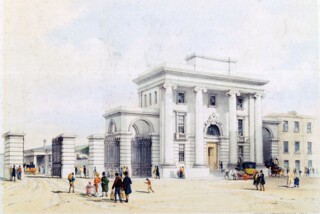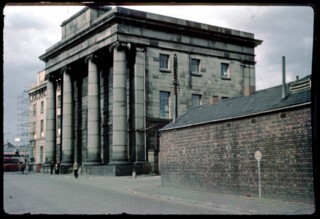Over the years , travelling to Birmingham from time to time, I’ve noticed a handsome classical building, a kind of mirage that comes into view briefly as the train approaches New Street Station. Then, like almost everyone else it seems, I forget all about it – not even bothering to find out what it was. Stranded, isolated and distant in a nondescript wasteland of car parks and low-key dereliction, the ghostly, tarnished building with its handsome Ionic columns and boarded-up windows always looked uncannily like a sibling of the much lamented Euston Arch, demolished in 1961. And so it is.
Philip Hardwick’s Birmingham Station was designed to be the bookend to his Greek Doric triumphal arch into London’s Euston. Opened in 1838, it’s the oldest monumental railway building in the world, Grade 1 listed. Soon renamed Curzon Street Station, from the 1850s onwards the proliferation of Midlands railway lines and emergent companies saw the elegant little palazzo demoted to be a goods depot. No passengers ever crossed the threshold again. It finally closed in 1966, to be left to the mercies of Birmingham City Council but still haunting the view from the train windows. Schemes to include it somehow as part of ambitious developments came and went. But the immense Birmingham interchange being dreamed up for HS2 will, they say, be called Curzon Street too, and so Hardwick’s handsome ticket hall may yet have a role, even if it’s largely symbolic.
The story of Curzon Street Station is an extreme illustration of what can happen to a building when architectural quality plays no part and utility is all. From the late 19th century onwards depreciation was always factored into the economics of building and development, but obsolescence is far from an exact science, as Daniel Abramson’s succinct, thoughtful book Obsolescence: An Architectural History shows.* Abramson, carefully transatlantic in his thinking, charts the ebb and flow of ideas which, as he writes ‘ran the gamut from accepting that obsolescence would happen to believing that obsolescence should happen’, liberating us all from ‘history and habit’. In the early 20th century the drive was towards ‘a relentless, universal, impersonal process of devaluation and discard’ – but then came reaction.
By the mid-century, obsolescence held endless promise: there were new ideas about the accommodating nature of flexible interior space (sometimes encased in impregnable béton brut); there was the thrill of modular megastructures, plug-in and pop-up. A network of mutually reinforcing theorists warmed to the idea. Abramson takes in Cedric Price’s giant unbuilt Fun Palace in the East End of London, the graphic visions of Archigram, Reyner Banham’s celebration of the ‘aesthetics of expendability’ and Colin Rowe’s arguments for collage and the reinstatement of the ‘leftovers of the world’ within wider urban design. For their part, civic activists and urban thinkers such as Jane Jacobs and Herbert Gans saw those ‘leftovers’ in strong social and economic terms. The oil crisis shook the ‘obsolescence paradigm’ of unlimited growth and consumption to the core; adaptive reuse and sustainability entered the equation, challenging capitalist hubris and architectural mesmerism alike. In the midst of it all Reyner Banham became revisionist; now he considered megastructures to be obsolete. The brutalist Thamesmead (built by the GLC from 1967 onwards) was, he said, ‘the ultimate tombstone of the institutionalised and run-down concept’.
Real behemoths of obsolescence can still be seen along the Thames. The Millennium Mills in Silvertown, close to the Royal Victoria Dock, are a fixed point in the shifting built landscape that spools out and, increasingly, rears up in front of passengers on the Docklands Light Railway. The flourmills narrowly survived the explosion of a Silvertown munitions factory in 1917 only to be rebuilt in 1933 by their then owners, Spillers, in cut-price industrial Art Deco. Hardly ten years on they were badly bomb-damaged, but they stayed standing, loved and partly listed, while becoming an ever more intractable problem due to the quantities of asbestos inside. (They offered an attractive challenge for thrill-seeking extreme urban adventurers.) After decades of uncertainty and more than one elaborate failed redevelopment plan, the government funded the asbestos removal last year, which cost £12 million. Battered but not yet on the ropes, the ten-storey Millennium Mills have now been pitched as the focal point of a new business centre under the aegis of the Silvertown Partnership. Look a bit more closely, and the Enterprise Zone in which the mills have been included since 2013 turns out to be energetically courting the South-East Asian market. As Abramson points out, capitalist modernisation has wiped out obsolete areas of Chinese cities with a ruthlessness not seen since Chicago a century ago. For the Millennium Mills, Crossrail is coming and perhaps the Chinese too – suggesting, just possibly, the end of their obsolescence.
Ninety years after they were built, the original Shredded Wheat grain silos of Welwyn Garden City stand as landmarks on the train journey north to York and Edinburgh or south to King’s Cross. With an injection of near shocking modernity the French-Canadian architect Louis de Soissons, master planner of Ebenezer Howard’s second garden city, broke away from mildly neo-Georgian architecture and Beaux Arts planning and raised his game considerably. He must have read le Corbusier’s Vers une architecture; by the time of its English edition in 1927 the complex, with its 18 towering concrete silos, was installed along the railway line. Out on the Calgary prairies, Corb reminded his readers, these heroic silos expressed the central tenets of functional modernism to a T. An unfamiliar building type in bosky suburban Hertfordshire, the silos neatly flagged up the transatlantic origins of the parent company, Nabisco, while at breakfast tables around the new town families sat munching their very own Welgar Shredded Wheat.
Nabisco was eventually gobbled up by Kraft, but continued to produce the same cereal in the same factory until 2008. Since then, Tesco’s plans for the extensive brownfield site have fallen foul of almost everyone. Elsewhere, the silo challenge has produced interesting results. In Johannesburg and Oslo they have been converted into student housing with a difference, while out on the wilder shores of invention, two Swedish architecture students have proposed an enchanted crematorium and vertical cemetery in a disused grain silo in Malmö.
It falls to the current generation of building professionals to drive the move towards sustainability. The Bartlett School of Architecture at UCL recently decided that its own unlovely 1975 home, Wates House, was no longer fit for purpose. On practical grounds alone, the architects Hawkins/Brown took the step of retaining the concrete frame and retrofitting and heightening the building around it. So as you walk or cycle towards Euston station, where perhaps a statue to Philip Hardwick should stand (but doesn’t), you will pass an excellent model of sustainability, particularly germane for students at the Bartlett, whether architects, urban designers or planners. Sustainability, Abramson writes, generates its own uncertainties and, who knows, new creative potential. As he concludes, ‘accident and agency, along with the evolution of internal contradictions, helped invent obsolescence and then sustainability.’ Leave it to the buildings: they often have the best answers.
Send Letters To:
The Editor
London Review of Books,
28 Little Russell Street
London, WC1A 2HN
letters@lrb.co.uk
Please include name, address, and a telephone number.



